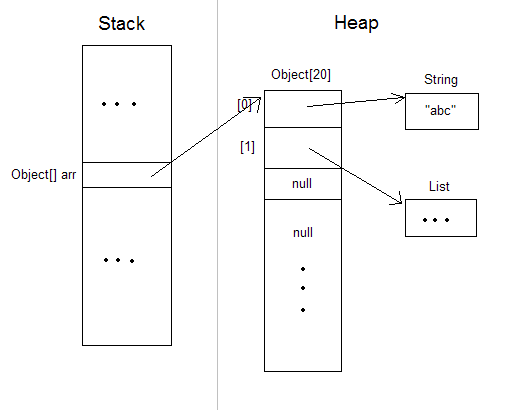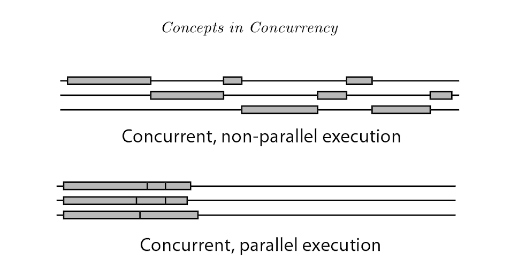What is Thread in Java?
Thread is an independent path of execution.
Difference between Thread and Process
The thread is a subset of Process, in other words, one process can contain multiple threads. Two process runs on different memory space, but all threads share same memory space.
How do you implement Thread in Java?
By extending java.lang.Thread class
By implementing java.lang.Runnable interface.
Which way of implementing Thread is better? Extending Thread class or implementing Runnable method?
Implementing Runnable is better because in Java we can only extend one class so if we extend Thread class we can not extend any other class while by implementing Runnable interface we still have that option open with us
What is the difference between start() and run() method of Thread class?
start() method is used to start newly created thread, while start() internally calls run() method
When you invoke run() as normal method, its called in the same thread, no new thread is started
Q1.Difference between Concurrency and Parallelism
Concurrency is when two or more tasks can start, run, and complete in overlapping time periods. It doesn’t necessarily mean they’ll ever both be running at the same instant. For example, multitasking on a single-core machine.In Concurrency Interruptability exists
Parallelism is when tasks literally run at the same time, e.g., on a multicore processor.In Parallelism Independabality exists.
Concurrency Concurrency + parallelism
(Single-Core CPU) (Multi-Core CPU)
___ ___ ___
|th1| |th1|th2|
| | | |___|
|___|___ | |___
|th2| |___|th2|
___|___| ___|___|
|th1| |th1|
|___|___ | |___
|th2| | |th2|
In both cases we have concurrency from the mere fact that we have more than one thread running.If we ran this program on a computer with a single CPU core, the OS would be switching between the two threads, allowing one thread to run at a time.If we ran this program on a computer with a multi-core CPU then we would be able to run the two threads in parallel – side by side at the exact same time.
Q2.What is the difference between process and threads
Process:
- An executing instance of a program is called a process.
- Some operating systems use the term ‘task‘ to refer to a program that is being executed.
- A process is always stored in the main memory also termed as the primary memory or random access memory.
- Therefore, a process is termed as an active entity. It disappears if the machine is rebooted.
- Several process may be associated with a same program.
- On a multiprocessor system, multiple processes can be executed in parallel.
- On a uni-processor system, though true parallelism is not achieved, a process scheduling algorithm is applied and the processor is scheduled to execute each process one at a time yielding an illusion of concurrency.
- Example: Executing multiple instances of the ‘Calculator’ program. Each of the instances are termed as a process.
Thread:
- A thread is a subset of the process.
- It is termed as a ‘lightweight process’, since it is similar to a real process but executes within the context of a process and shares the same resources allotted to the process by the kernel.
- Usually, a process has only one thread of control – one set of machine instructions executing at a time.
- A process may also be made up of multiple threads of execution that execute instructions concurrently.
- Multiple threads of control can exploit the true parallelism possible on multiprocessor systems.
- On a uni-processor system, a thread scheduling algorithm is applied and the processor is scheduled to run each thread one at a time.
- All the threads running within a process share the same address space, file descriptors, stack and other process related attributes.
- Since the threads of a process share the same memory, synchronizing the access to the shared data within the process gains unprecedented importance.
Q3.Why should I prefer Thread over process?
Inter-thread communication (sharing data etc.) is significantly simpler to program than inter-process communication.
Context switches between threads are faster than between processes. That is, it’s quicker for the OS to stop one thread and start running another than do the same with two processes.
Example:
Applications with GUIs typically use one thread for the GUI and others for background computation. The spellchecker in MS Office, for example, is a separate thread from the one running the Office user interface. In such applications, using multiple processes instead would result in slower performance and code that’s tough to write and maintain.
It entirely depends on the design perspective whether to go for a thread or process. When I want to set of logically co-related operations to be carried out parallel. For example, if you run a Notepad++ there will be one thread running in the foreground as an editor and other thread running in background auto saving the document at regular intervals so no one would design a process to do that autosaving task separately.
Q4.What is the difference between Asynchronous vs synchronous execution?
synchronous – When you execute something synchronously, you wait for it to finish before moving on to another task. You are in a queue to get a movie ticket. You cannot get one until everybody in front of you gets one, and the same applies to the people queued behind you.
asynchronous -When you execute something asynchronously, you can move on to another task before it finishes. i.e. You are in a restaurant with many other people. You order your food. Other people can also order their food, they don’t have to wait for your food to be cooked and served to you before they can order. In the kitchen, restaurant workers are continuously cooking, serving, and taking orders. People will get their food served as soon as it is cooked.
Synchronous (one thread):
Single Thread |--------A--------||--------B--------|
Synchronous (Multi-Threaded):
Thread A |--------A--------|
Thread B |--------B--------|
Thread C |--------C--------|
ASynchronous (One thread):
A-Start ------------------------------------------ A-End
| B-Start -----------------------------------------|--- B-End
| | C-Start ------------------- C-End | |
| | | | | |
V V V V V V
Single thread->|--A-|---B---|--C-|-A-|-C-|--A--|-B-|--C---|---A---|--B-->|
Asynchronous (Multi-Threaded):
Thread A -> |----A-----|
Thread B -----> |-----B-----------|
Thread C ---------> |-------C----------|
Q5.What is Difference between thread, process and Tasks?
Process
A process is an instance of a computer program that is being executed.a process may be made up of multiple threads of execution that execute instructions concurrently.Process-based multitasking enables you to run the Java compiler at the same time that you are using a text editor. In employing multiple processes with a single CPU,context switching between various memory context is used. Each process has a complete set of its own variables.
Process
A thread is a basic unit of CPU utilization, consisting of a program counter, a stack, and a set of registers. A thread of execution results from a fork of a computer program into two or more concurrently running tasks. The implementation of threads and processes differs from one operating system to another, but in most cases, a thread is contained inside a process. Multiple threads can exist within the same process and share resources such as memory, while different processes do not share these resources.
Tasks
A task is a set of program instructions that are loaded in memory.
Q6.What is Interprocess Communication?
Interprocess communication (IPC) is a set of programming interfaces that allow a programmer to coordinate activities among different program processes that can run concurrently in an operating system. This allows a program to handle many user requests at the same time. Since even a single user request may result in multiple processes running in the operating system on the user’s behalf, the processes need to communicate with each other. The IPC interfaces make this possible. Each IPC method has its own advantages and limitations so it is not unusual for a single program to use all of the IPC methods.
Java interprocess communication is based at the lowest level on turning state, requests, etc into sequences of bytes that can be sent as messages or as a stream to another Java process. You can do this work yourself, or you can use a variety of “middleware” technologies of various levels of complexity to abstract away the implementation details. Technologies that may be used include, Java object serialization, XML, JSON, RMI, CORBA, SOAP / “web services”, message queing, and so on.
Q7.Interprocess Communication vs Inter-Thread Communication?
The fundamental difference is that threads live in the same address spaces, but processes live in the different address spaces. This means that inter-thread communication is about passing references to objects and changing shared objects, but processes is about passing serialized copies of objects.In practice, Java interthread communication can be implemented as plain Java method calls on a shared object with appropriate synchronization thrown in.
Inter-Thread Communication = threads inside the same JVM talking to each other.Threads inside the same JVM can use pipelining through lock-free queues to talk to each other with nanosecond latency.
Inter-Process Communication (IPC) = threads inside the same machine but running in different JVMs talking to each other.Threads in different JVMs can use off-heap shared memory (usually acquired through the same memory-mapped file) to talk to each other with nanosecond latency.
Q8.What is Starvation?
Starvation describes a situation where a thread is unable to gain regular access to shared resources and is unable to make progress. This happens when shared resources are made unavailable for long periods by “greedy” threads. For example, suppose an object provides a synchronized method that often takes a long time to return. If one thread invokes this method frequently, other threads that also need frequent synchronized access to the same object will often be blocked.
Q9.What is Livelock?
A thread often acts in response to the action of another thread. If the other thread’s action is also a response to the action of another thread, then livelock may result. As with deadlock, livelocked threads are unable to make further progress. However, the threads are not blocked — they are simply too busy responding to each other to resume work. This is comparable to two people attempting to pass each other in a corridor: Alphonse moves to his left to let Gaston pass, while Gaston moves to his right to let Alphonse pass. Seeing that they are still blocking each other, Alphone moves to his right, while Gaston moves to his left. They’re still blocking each other, so…
Q10.Preemptive vs Non-Preemptive Scheduling
Scheduling is order of executuion of threads. JVM would simply use the underlying threading mechanism provided by the OS.
Non-preemptive Scheduling: The current process releases the CPU either by terminating or by switching to the waiting state. (Used in MS Windows family)
Advantages are Decreases turnaround time and Does not require special HW (e.g., timer)
Disadvantages are Limited choice of scheduling algorithm
Preemptive Scheduling: The current process needs to involuntarily release the CPU when a more important process is inserted into the ready queue or once an allocated CPU time has elapsed. (Used in Unix and Unix-like systems).This is determined by priority assigned to thread.Despite priority JVM may decide to execute thread of lower priority inorder to avoid starvation.
Advantages are No limitation on the choice of scheduling algorithm
Disadvantages are Additional overheads (e.g., more frequent context switching, HW timer, coordinated access to data, etc.)
Q10.
Q11.
Q12.
Q13.
Q14.




